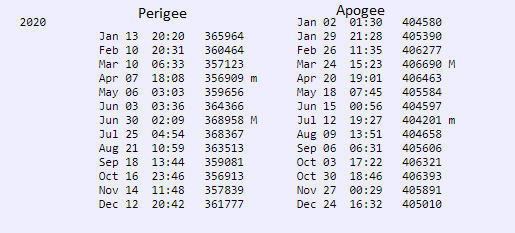Above: A simulation of the moon’s phase on June 29-30, 2020, as our companion world reaches its second lunar perigee of this month. The image is via Fourmilab.
The moon in its orbit swings closest to Earth at perigee, and farthest away from Earth at apogee. There are a total of 13 lunar perigees in 2020, so it’s inevitable that one calendar month this year has to harbor two lunar perigees. That double feature happens in June 2020. Depending on where you live worldwide, the second of two June 2020 perigees falls on June 29 or 30 (June 30 at 02:09 UTC). A playful person might wish to call this a Blue Moon perigee, given the popular definition of Blue Moons as the second full moon of a month, and given that this June 29-30 perigee is the second of two lunar perigees this month.
Read more: When is the next Blue Moon?
The first lunar perigee fell on June 3, 2020 at 03:36 UTC.
The second one falls on June 30, 2020 at 2:09 UTC. Converting Universal Time to time zones in North America and the United States, that places the month’s second lunar perigee on June 29, 2020, at 11:09 p.m. ADT, 10:09 p.m. EDT, 9:09 p.m. CDT, 8:09 p.m. MDT, 7:09 p.m. PDT, 6:09 p.m. AKDT (Alaskan Daylight Time) and 4:09 p.m. HST (Hawaiian Standard Time).
The second lunar perigee on June 30, 2020, is 2,853 miles (4,592 km) more distant than the first perigee on June 3:
First lunar perigee on June 3, 2020: 226,407 miles (364,366 km)
Second lunar perigee on June 30, 2020: 229,260 miles (368,958 km)
Moreover, the second lunar perigee in June 30 counts as the farthest lunar perigee of the year. The June 30 perigee is a whopping 7,488 miles (12,051 km) farther than the year’s closest perigee on April 7, 2020.
Closest lunar perigee on April 7, 2020: 221,772 miles (356,907 km)
Farthest lunar perigee on June 30, 2020: 229,260 miles (368,958 km)

Nearly two weeks from now – on July 12, 2020 – at 19:27 UTC, it’ll be the closest apogee of the year: 251,158 miles (404,199 km). Contrast this distance with that of the year’s farthest apogee that took place on March 24, 2020: 252,707 miles (406,692 km). The difference in distance between the year’s closest and farthest apogees amounts to 1,549 miles (2,493 km).
The difference in distance between this year’s closest and farthest perigees (7,488 miles or 12,051 km) far and away exceeds the gap between the year’s closest and farthest apogees (1,549 miles or 2,493 km). That’s 4.8 times greater!
That is the case in any year. There’s always a wide difference in distance between the year’s closest and farthest perigees, but a rather narrow gap between the year’s closest and farthest apogees.

Bottom line: Enjoy the moon in all its majestic mystery as it reaches its second perigee of the month on June 29-30, 2020. This perigee is also the moon’s most distant perigee of the year.











